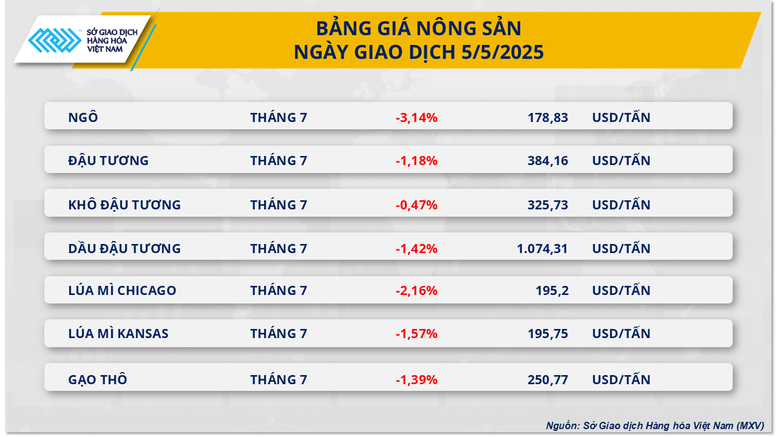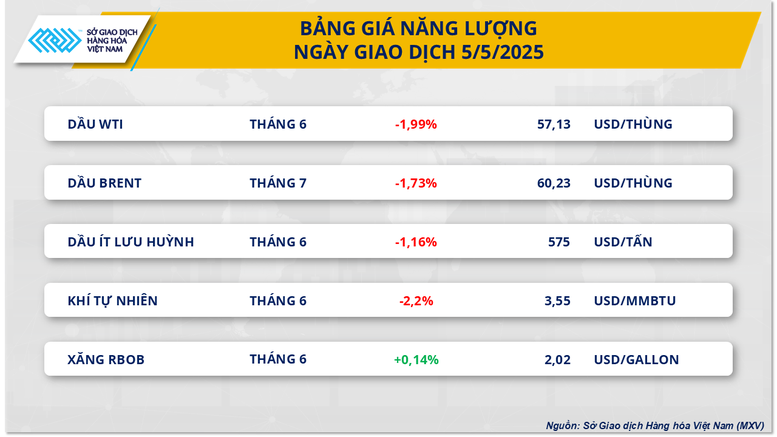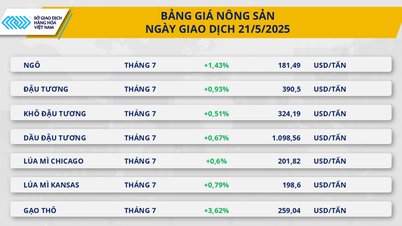In the agricultural market, according to MXV, the prices of all 7 agricultural products decreased simultaneously in the trading session on May 5. Of which, corn prices led the decline when they plunged more than 3% to 178 USD/ton. The closing price near the session bottom showed that negative sentiment still dominated the market.
According to MXV, geopolitical and trade uncertainties have been part of the reason for the sharp drop in corn prices.
Chicago wheat also fell sharply, dropping nearly 2.1% to $195 a ton yesterday. Despite opening in the green, wheat prices quickly lost momentum and closed at the low of the day.
Russian wheat export prices continued to fall over the past week as the new crop is approaching and no significant damage from previous frosts was recorded, experts said.

On the other hand, US wheat exports have shown signs of slowing down. Data from Export Inspections shows that wheat deliveries last week were only 310,000 tonnes, down sharply from 649,000 tonnes the previous week and 339,000 tonnes a year ago, reflecting a weakening demand for US wheat in the short term.
For the energy group, the downward trend of oil prices continued to extend into the first trading session of the week when OPEC+ officially announced its decision to increase production for June, fueling concerns about the prospect of a global supply surplus.
At the end of the trading session, Brent oil price stopped at 60.23 USD/barrel, down 1.73%. Similarly, WTI oil price continued to decrease by 1.99%, down to 57.13 USD/barrel. These are the two lowest price levels of these two commodities since February 2021.

The downward pressure on prices was mainly due to OPEC+’s decision on May 3 to increase production by 411,000 barrels per day in June, similar to the increase in May. Combined with a slight increase in April, OPEC+’s total production increase in the second quarter reached 960,000 barrels per day. OPEC+ said the move was based on a healthy oil market and low inventories. However, many experts warned that continuing to increase production amid an unclear global oil demand outlook could put the market at risk of a prolonged oversupply.
In fact, OPEC+ is still dealing with the situation of some members such as Iraq and Kazakhstan producing more than their quotas, with Kazakhstan even publicly stating that it is not focusing on cutting production to the level allowed by OPEC+. These developments have further increased concerns about oversupply in the oil market.
In addition to supply factors, market sentiment is also under pressure from the prospect of weakening demand. On May 5, S&P Global announced that the services PMI and composite PMI indices both fell more than expected, continuing a series of negative signals about the health of the US economy - an economy that just experienced its first quarter of deflation in three years.
The rare bright spot that helped curb the decline in oil prices came from expectations of new trade agreements between the US and major partners, especially China, along with the ISM non-manufacturing PMI index that was more positive than expected by the market. However, overall, the oil market still faces great pressure from the risk of oversupply when the demand outlook has not really improved.
Source: https://baodaknong.vn/thi-truong-hang-hoa-6-5-sac-do-tiep-tuc-bao-trum-len-thi-truong-251620.html




![[Photo] Prime Minister Pham Minh Chinh chairs the Government's special meeting on law-making in May](https://vphoto.vietnam.vn/thumb/1200x675/vietnam/resource/IMAGE/2025/5/22/1c880aae96fd4e0894abc47a46fe19ba)
![[Photo] General Secretary To Lam chairs a working session with the Central Internal Affairs Commission](https://vphoto.vietnam.vn/thumb/1200x675/vietnam/resource/IMAGE/2025/5/22/3b7790f499da45b2803d8ae253207ef1)












































































Comment (0)